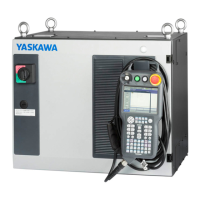SAFEGUARDING TIPS
9
179526-1CD
179526-1CD
READ FIRST!! Safety
Requirements YRC1000
SAFEGUARDING TIPS
All operators, programmers, maintenance personnel, supervisors, and
anyone working near the system must become familiar with the operation
of this equipment. All personnel involved with the operation of the
equipment must understand potential dangers of operation. General
safeguarding tips are as follows:
When installing the robot system, avoid interference with building
structures, utilities, other machines and equipment that may create
trapping or pinch points.
Supplementary audible means of robot operation is provided, the
supplementary audible shall exceed the ambient noise at the end-use
application if adding.
If providing more than one emergency stop button, each button shall be
marked to indicated its designated safety function if it does not stop all
robot workcell motion.
Making changes or additions to the applicable information provided by
manufacturer are to be provided by the party making the changes or
additions.
Improper operation can result in personal injury and/or damage to the
equipment. Only trained personnel familiar with the operation of this
equipment, the operator's manuals, the system equipment, and options
and accessories should be permitted to operate this equipment.
Improper connections can damage the equipment. All connections must
be made within the standard voltage and current ratings of the equipment.
The system must be placed in Emergency Stop (E-Stop) mode whenever
it is not in use.
In accordance with ANSI/RIA R15.06-2012, section 4.2.5, Sources of
Energy, use lockout/tagout procedures during equipment maintenance.
Refer also to Section 1910.147 (29CFR, Part 1910), Occupational Safety
and Health Standards for General Industry (OSHA).
MECHANICAL SAFETY DEVICES
The safe operation of this equipment is ultimately the users responsibility.
The conditions under which the equipment will be operated safely should
be reviewed by the user. The user must be aware of the various national
codes, ANSI/RIA R15.06-2012 safety standards, and other local codes
that may pertain to the installation and use of this equipment.
Additional safety measures for personnel and equipment may be required
depending on system installation, operation, and/or location.
Check all safety equipment frequently for proper operation. Repair or
replace any non-functioning safety equipment immediately.

